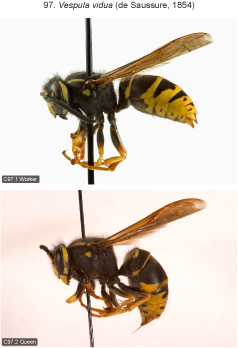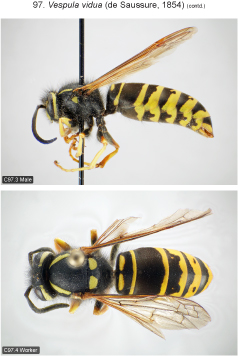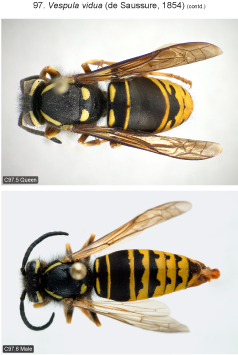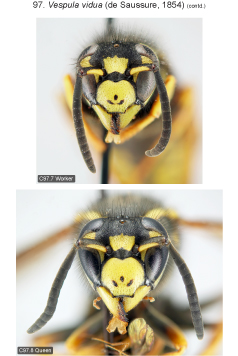
| Home | Table of contents | Keys | Species list | Glossary | Image data | PDF | Cite this article | Feedback | Updates |
Identification Atlas of the Vespidae (Hymenoptera, Aculeata) of the northeastern Nearctic region
CJAI 05, February 19, 2008
doi: 10.3752/cjai.2008.05
Matthias Buck, Stephen A. Marshall, and David K.B. Cheung
Department of Environmental Biology, University of Guelph, Guelph, Ontario, Canada N1G 2W1
Next species | Previous species | Key
97. Vespula vidua (de Saussure, 1854)
Figs B13.3, 4, 6, 36, 59, 70; C97.1–10.
 |
 |
 |
 |
 |
Species recognition. The queen of this species is easily recognisable by the presence of enclosed yellow spots on tergum 1, largely black tergum 2, median black mark with ‘ear’-like processes on tergum 3 (the processes becoming separate spots in xanthic specimens), and largely yellow terga 4 and 5 with free, black, discal spots. Workers and males can be separated from similar species (V. acadica, V. austriaca) by the very short and sparse pubescence on discs of terga 2–6 and other characters mentioned in the key.
Variation. Fore wing length 9.5–12.0 mm (workers), 14.0–15.0 mm (♀♀), ca. 11.0–14.0 mm (♂♂). Clypeus with three small black discal spots, in worker rarely confluent and forming single, anchor-shaped mark; in male often obliterated or reduced to one medial spot. Yellow stripe along inner orbit usually ending on upper margin of sinus, rarely abbreviated and ending near apex of ocular sinus in male and worker. Yellow postocular band usually interrupted near middle, rarely complete but then significantly narrowed (exceptionally hardly narrowed) or enclosing black spot; postocular band entire and not narrowed near middle in male. Metanotum black, worker exceptionally (1 specimen, ON, Dundas, DEBU) with tiny, evanescent yellow spots. ‘Ear’-shaped processes of black medial mark of tergum 3 of females sometimes forming separate spots in xanthic specimens; in worker usually, in queen the ‘ear’-shaped processes very rarely completely merging with black basal band. Enclosed yellow spots rarely present on tergum 3 (in female, very rarely in queen) or 4 (male). Queen always, worker usually, and male sometimes with pairs of black discal spots on terga 4 and 5.
Distribution. Canada: NS to ON (not recorded from PE), MB (Galloway and Preston 1982). Eastern U.S. south to GA along Appalachians, west to ND, SD, IA, IL and KY (Carpenter and Kojima 1997).
Biology. Nests are usually subterranean; they rarely are built in decaying logs or manmade structures. Females prey on live arthropods and are rarely a nuisance to man (Akre et al. 1981).
Next species | Previous species | Key
| Home | Table of contents | Keys | Species list | Glossary | Image data | PDF | Cite this article | Feedback | Updates |
